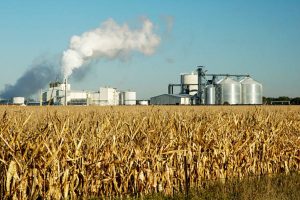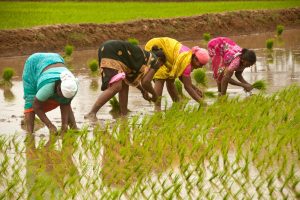Our problems are man-made; therefore they can be solved by man. And man can be as big as he wants.Man’s reason and spirit have often solved the seemingly unsolvable…and we believe they can do it again. ~ John F. Kennedy. After having declined for over a decade, global hunger is on the rise again with the “coexistence of various form of malnutrition”.
According to FAO, two billion people suffer from micronutrient deficiencies; 815 million are in a state of calorific deficit; nearly one in four children suffers from chronic malnutrition, 52 million children suffer from acute malnutrition; and two billion adults are overweight. The world is now reeling under the impact of a climate disaster; the global temperature has only increased by 10 Celsius from pre-industrial levels.
The latest report of the UN entitled “The State of Food Security and Nutrition in the World 2018 states: “Climate variability and extreme conditions are a key-driver behind the recent rise in global hunger and one of the leading causes of severe food crises.’ However, the climate change has aggravated food and nutrition security to such an extent that the issue of food security and food production will definitely be a major focus of the 6th Assessment Cycle of the Intergovernmental Panel on Climate Change (IPCC) 6th Assessment Cycle.
The world over, plants, animals, and ecosystems are accustomed to the prevailing climatic conditions. When these conditions change, even slightly, favorably or unfavorably, plants and animals are affected. Presently, all regions of the world, from Kerala to California, are experiencing, and will continue to experience, the extreme weather developments with varying magnitude and consequences. Climate change is already affecting food availability, reducing access to food, impinging on food quality.
The implications may even result in malnutrition. A study of global vegetable and legume production concluded that if Greenhouse gases (GHGs) emissions continue on their current trajectory, food production could decline by 35 per cent by 2100 due to water scarcity and increased salinity and ozone. Climate change has already affected the quantity of food produced globally even though it is small when compared with the significant increase in global food production.
The rise in mean temperature of the order of 2 degrees C to 3 degrees C will lead to a reduction of the wheat crop in North India, resulting in a loss of 6 to 7 million tons of wheat every year. As temperatures continue to increase, corn (maize) ~ the most widely grown crop in the world ~ appears to be the most vulnerable to heat stress. Every day during the growing season ~ roughly from March to the end of August ~ temperatures rise above a threshold of 29 degrees C.
This leads to a 0.7 per cent drop in corn yield. As the temperatures rise above the threshold mark, the yield declines further with every additional degree. The risk is dangerously real for the four corn exporters ~ the US, Brazil, Argentina and the Ukraine. These countries are facing simultaneous crop failures. If the temperatures rise above 4 degrees C, the odds shoot up to a staggering 86 per cent. The impact on crop yields will definitely aggravate the plight of the world’s poorest and sharpen the rich/ poor divide that already exists.
A researcher at the International Rice Institute in the Philippines, Shaobing Peng, showed that the yield of rice declined by 10 per cent with every one degree Celsius increase in night-time temperature during the dry part of the growing season, even though there were no significant drops in yields associated with increasing maximum temperatures during daytime. Crop disease and pests are also increasing along with global warming. One of the leaders of an Asian international agricultural research group, P K Agrawal, has said: ‘Warmer conditions and longer dry seasons linked to climate change could prove to be the perfect catalyst for outbreaks of pests and diseases.’
Temperature is probably the single most important environmental factor influencing insect behaviour, distribution, development, survival, and reproduction. It has been estimated that with a 20 degrees C temperature increase, insects might experience one to five additional life cycles per season. Higher temperatures are leading to a dramatic expansion in the range of insects that are harmful to food crops, sending them farther north in the northern hemisphere and farther south in the southern hemisphere, and towards higher altitudes. According to the crop scientists, the increase in the “pest population” could have a substantial economic impacts through increased seed and insecticide costs, decreased yields and the downstream effects of changes in crop yields.
Soyabean has a higher threshold for heat stress than corn, but has been established that a higher carbon dioxide level can result in soyabean deactivating genes that are crucial to the production of chemicals that help to defend them against insects by blocking the enzymes in the stomach of beetles that digest soybeans plants, and by deactivating other genes used by the soyabean to attract the natural enemies of the beetles. As a result, the soybean that is grown in higher levels of CO2 appear to be helpless against herbivores. Eighty per ent of the world’s crops are rainfed.
When temperatures rise, the warmer air holds more moisture and can make precipitation more intense. Extreme precipitation can damage crops resulting in decreased yields. A rise in the sea level can submerge crops. Hotter weather will lead to faster evaporation, resulting in drought and water shortage. Presently, nearly 42.4 per cent of India is now droughtaffected. About 10 per cent of the crops grown in the major food production regions are irrigated with groundwater.
In India 60 per cent of agriculture and 85 per cent of drinking water supplies are dependent on groundwater. In many areas, withdrawals from aquifers far exceed the rate of replenishment. Climate change can lead to desertification by altering atmospheric circulation patterns and drying out the land and vegetation. The same extra heat that evaporates more water vapour from the oceans also speeds up the evaporation of soil moisture, resulting in extensive drought. Since the refilling of the atmospheric ‘basins’ of moisture still takes a lot of time, many areas of the world are experiencing longer periods without rain in between the intense downpours.
These longer periods of hotter temperatures lead to more widespread and prolonged drought. Once it is devoid of vegetation, the surface begins to absorb more heat. When the soil moisture is gone, the ground gets baked, and the top soil becomes more vulnerable to wind erosion. Topsoil regenerates naturally, but at the amazingly slow rate of approximately 2.5 centimetres every 500 years. Some studies indicate that half of India’s geographical area is degraded and suffers from soil erosion. Each inch of topsoil lost diminishes grain yields by 6 per cent. Apart from quantity, climate change can severely affect the quality of food.
The FAO has aptly pointed out that ‘Climate change directly affects food and nutrition security,, undermining current efforts to address undernutrition and hitting the poorest the hardest especially women and children.’ Indian agriculture is particularly vulnerablee to climate change. The best way to reduce these risks to our food security is to implement policies to cut emission of greenhouse gases. In the words of E. F. Schumacher: ‘The chance of mitigating the rate of resource depletion or of bringing harmony into the relationship between people and their environment is non-existent as long as there is no idea anywhere of a life-style which treats enough as good and morethan- enough as evil. Here lies the real challenge, and no amount of technical ingenuity can evade it.’
(The writer is a retired IAS officer)











